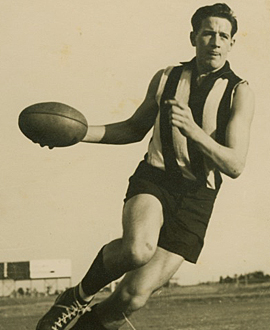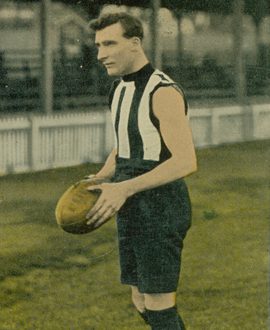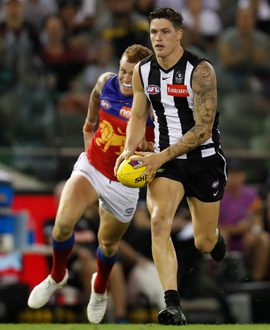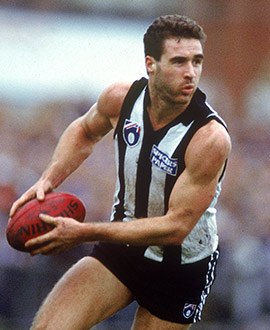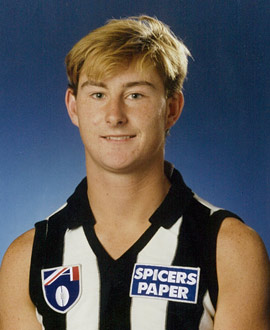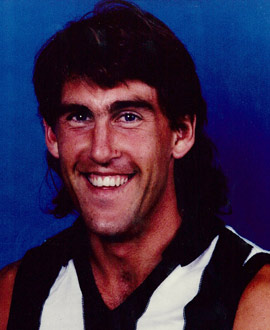By: Glenn McFarlane
It started out with a half-page in the newspapers placed by the AFL with the emotive image of a Sherrin behind barbed wire with the message: "Is this how you want to watch football?"
It ended without controversy, some rare praise from an opposition coach about the Victoria Park crowd, and with one of the greatest winning margins in the history of the Collingwood Football Club.
The first time Collingwood met Adelaide was in round 15, 1991, at Victoria Park, and Adelaide was in its inaugural season, having won its first match in Melbourne only the previous week against Richmond.
Collingwood was finally emerging from the hangover that followed the drought-breaking 1990 premiership success.
And the AFL was fearful of trouble about Crows' journey almost back in time to the football tribalism of Victoria Park might elicit some trouble.
A week earlier there had been discontent following the Carlton-West Coast game at Princes Park, when Blues fans clashed with Eagles players in what the league feared was a disturbing sign of the times.
Hence, the inflammatory ad that appeared on the day of the Crows' first game against the Magpies.
In the lead-up to the match, Collingwood's Ross "Twiggy" Dunne - the man who had slotted through one of the club's most famous torpedo punts in the 1977 drawn Grand Final - assured fans and the AFL that all would be fine in terms of safety.
Dunne, in charge of ground control - which was almost as much a balancing act as playing in the Magpies' attack in his day - said: "We will be seeking the co-operation of the cheer squads to make sure there is just the good-natured barracking and nothing more."
Lou Richards was only joking when he wrote in his well-digested Kiss of Death column on the morning of the match: "Have you heard the one about the Adelaide supporter who jumped off the Overlander (train) at Spencer Street and asked a one-eyed Magpie how far it was to Victoria Park? 'About five kilometres, as the Crow dies' was the reply.
"I'm not saying Collingwood will kill them this weekend, but as sure as Crows eggs they will more than just ruffle the feathers of those South Aussie birds."
A joke? Yes. A little inflammatory? Perhaps. A well-held belief that there might be trouble? Well, the AFL thought so.
Adelaide coach Graham Cornes wasn't worried. He told his players to savour the experience of playing at one of the most intense suburban footy cauldrons.
He even took them to Victoria Park at 9.30am on the morning of the match, sneaking their way into the venue long before the seconds match had kicked the dew off the grass, to get an early inspection.
He explained: "We had no trouble getting on to the ground ... and the windsock was flying.
"The curator was there to open the door. We thought it was a fairly positive preparation. But they (Collingwood) had the last laugh."
The last laugh came in the form of a 123-point flogging of Adelaide. At the time it was Collingwood's fifth greatest winning margin in what was essentially the club's 100th season (1892-1991). It remains the club's sixth greatest winning margin after the 138-point win over Port Adelaide in 2011 jumped over the top of it and others.
This was the third successive win for the Magpies, following on from a six-week losing streak that defined its hangover. A week earlier they had beaten Sydney by 99 points (again at Vic Park).
Part of the reason came from the fact that Collingwood once more had a sniff of what would be an unlikely finals bid - one that would ultimately fail - following a frustrating start to the year where injuries and inconsistent form wrecked the flag defence.
And in this match against Adelaide, captain Tony Shaw and star forward Peter Daicos made their returns from injury. Shaw had missed the previous week with a back injury, while Daicos had been out for three weeks with an ankle injury.
That meant there were only four players missing from the 1990 flag side - Denis Banks (injured), Mick McGuane (injured), Damian Monkhorst (emergency) and Doug Barwick (reserves).
The four who hadn't played in the previous year’s premiership but who played in that first game against the Crows were the unlucky Ron McKeown, who cruelly missed the premiership, as well as three teenagers - fifth-gamer Troy Lehmann (wearing No.15), sixth-gamer Mark Richardson (wearing No.16), 11th-gamer Paul Williams (wearing No.37).
And this was a game in which Magpies coach Leigh Matthews reshuffled his pack and it brought about one of the club’s most complete games of the season.
Richardson, the son of club great Wayne, showed plenty of promise in attack, which had the dual purpose of releasing Gavin Brown further up the field. Lehmann added some speed to the wing.
Shane Morwood was released to the half-forward line. James Manson, playing his 100th game, shared the ruck duties with Craig Starcevich and Michael Christian in the absence of Monkhorst.
And Graham Wright and Gavin Crosisca, as well as Shaw at times, spent time down back, adding pace to the back half.
The irony of this one-sided game was that four of the club's best players were native South Australians - Tony Francis, Lehmann, Scott Russell and Craig Kelly.
I was covering this match for the Sunday Herald Sun - in only my second season as an AFL reporter - and gave the three votes to Francis, who had 40 possessions, while the men in white gave the three Brownlow Medal votes to Lehmann, who had 30 touches.
Incredibly, Russell also had 40 touches, and he got the one Brownlow vote with Francis receiving the two votes.
Lehmann had kicked Collingwood's first goal at the six-minute-mark after a "snappy pass" from Daicos. It was the first of five goals the Magpies would kick against the wind - with the Crows kicking three goals with the breeze to the Yarra Falls end. Two of the home side goals came from 50m penalties.
It was the second term in which the Magpies asserted their authority. The Crows could not manage a goal against the breeze in that term - and the last - as their opponents slammed home six goals in the second quarter.
Two early ones came from Richardson, whose father was still on the club's board and was watching from the Collingwood Social Club. And the Magpie fans rose to their feet almost in unison as Daicos scored the first of two goals.
Richardson slotted through his third goal of the game to push his team to a 50-point lead at the long interval.
But that was not the end.
The Crows could only manage two goals for the third quarter, as the Magpies kicked seven goals against the wind, which had - admittedly - eased up by that stage.
Daicos and Wright went off the field carrying injuries but at least the former returned in the final term to help put a full stop on a memorable day for the Magpies.
Manson had come back from that year's pre-season campaign more than 10 kilos overweight following the previous year's flag, according to his coach, Leigh Matthews, many years later.
He kicked three final term goals, taking his tally to five goals. It was a fitting return for his 100th AFL game.
And Daicos slotted home a last-quarter goal from 45m out before putting the finishing touches with a long bomb that landed in the arms of Richardson, who kicked his sixth goal just before the final siren.
That meant Richardson had kicked 13 goals in two weeks, having booted seven against the Swans a week earlier.
The best news was there was no sign of trouble after the final siren. The Crows players vacated the arena after the final siren sounded, and the fans didn't stream onto the ground until after the second siren. More than 70 security, police and ground staff were on hand.
There were no barriers or barbed wire needed, even though one AFL official - the league's finance director Greg Durham - went incognito into the Vic Park outer to check out the crowd situation.
As Cornes said: "With all the hype surrounding this game, I think the actual conditions were an anti-climax. It was a typically enthusiastic football crowd supporting their team who were playing well.
"And that's what football is all about."
Matthews was delighted with the Collingwood performance that afternoon.
"They have been two very good performances (the Sydney and Adelaide games)," Matthews said.
"It has been an amazing turnaround. Certainly the balance of our team is much better physically with the players we now have available that weren't.
"We've got more speed now and players such as Lehmann and Williams are very quick."
The three teenagers who played for Collingwood that day would have different careers in black and white.
Richardson would manage 141 games for the Magpies and 83 goals in a career that never quite delivered what it had initially promised. But he was still a very good servant of the club who duly earned his life membership after his retirement.
Williams would be a superb player for the Magpies for a decade before a move to Sydney ended up in delivering him the premiership he craved in 2005.
And Lehmann would prove a case of what might have been. He would never again have 30 touches in a game and would never earn three Brownlow Medal votes again (he would have a pair of one-vote efforts still to come).
He would play 44 games for the club over three seasons before being traded to Brisbane - along with Starcevich - for a kid called Nathan Buckley.
As much as it was tough to let the promising Lehmann go, Buckley was a keeper.




